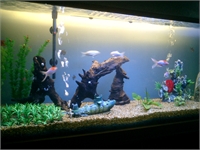
How to Care for a Freshwater Fish Tank
Important Notice: Our web hosting provider recently started charging us for additional visits, which was unexpected. In response, we're seeking donations. Depending on the situation, we may explore different monetization options for our Community and Expert Contributors. It's crucial to provide more returns for their expertise and offer more Expert Validated Answers or AI Validated Answers. Learn more about our hosting issue here.

How to Care for a Freshwater Fish Tank
You must be logged in to post a comment.
Just like any other pet, fish require proper care and a clean living environment. Keeping your fish tank clean takes time and effort to maintain water that is healthy for the fish. Fish tanks need to be cleaned once to twice a month, depending on the amount of fish in the aquarium. Maintaining a healthy living environment and maintaining beneficial levels of bacteria will ensure colorful, active, healthy, long-living fish.
Step 1
Remove any fish in the aquarium and place them into a quarantine tank. If a quarantine tank is not available leave the fish in the aquarium. You may want to purchase a tank divider to separate the fish from the area that you will be cleaning. This will avoid any accidental injury to your fish.
Step 2
Unplug and remove all the electrical items in the aquarium such as the heater, filter, power head, light and air stone. Make certain that the heater has cooled down before you remove it from the aquarium. If you remove it when it is still hot, the thermometer may break.
Step 3
Remove the aquariums hood and clean well. Clean the light bulbs once they have cooled down. Just wipe the hood and light down. You can use regular glass cleaner and an old cloth or paper towels.
Step 4
Change the filter’s materials such as the charcoal or the filter media. You can rinse the filer itself if there is a lot of build up, but try to avoid this. If you start cleaning everything too well essential bacteria gets lost. This bacteria is needed to support the eco balance in the aquarium.
Step 5
Scrub the sides of the tank using either an aquarium brush, scraper or magnet cleaner. I like to leave some algae growth on the back wall of the tank. This is convenient if you have snails or a pleco in your tank. It also gives the fish something to eat.
Step 6
Use the siphon tube to clean the gravel. You can find these in the aquatic isle of your local pet store. make sure you put the other end of the siphons’ tube into a bucket to catch the water waste. Clean only 50 percent to 75 percent of the gravel. Make certain not to lose more than 25 percent of the water. Again, over-cleaning the gravel will lead to loss of key bacteria needed in the aquarium.
Step 7
Replace the lost water during the cleaning by mixing a de-chlorinator and a stress coat together in a bucket of water. Follow the manufactures directions on the bottle for proper dosing. Make certain that the water replaced is within a few degrees of the existing water in the aquarium. Adding too hot or too cold of water can shock the fish and possibly kill them.
Step 8
Place the filter, power head, air stone and heater back in the aquarium. Put the aquarium hood and light fixture back on the aquarium.
Step 9
Plug in the filter and add water to back of the filter’s case. Continue to add water until the filter begins to suction and flow on its own. Now plug in all the remaining electrical items.
Step 10
Check the temperature of both the quarantine tank and to the cleaned aquarium. If the temperatures of the two tanks are within a few degrees of each other, the fish can now go back to the original aquarium.
Step 11
Using the glass cleaner and a soft cloth wipe down the outside front, back and sides of the aquarium, and wipe up any water that may have spilled on your stand.
Tips:
On a weekly basis, you should clean the aquarium hood, lights and outside of the tank. You should also use the scraper, sponge or magnet cleaner to clean the inside of the tank walls.
On a bi-monthly basis, you should do a 15 percent to 25 percent water change and change out the filter materials.
On a monthly basis, you should clean the gravel, and repeat all the steps as mentioned.